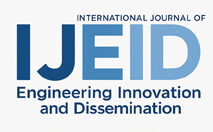IJEID Published Articles
International Journal of Engineering Innovation and Dissemination (IJEID) is a peer-reviewed, biannual journal published by VirtualRealia.Org. The journal focuses on disseminating innovative research that bridges the gap between theory and practice in engineering. IJEID welcomes high-quality contributions from various engineering disciplines, including interdisciplinary studies, that address real-world challenges, propose novel solutions, and advance engineering practices.
Design and Development of a Multi-Input Alternative Power Source for Emergency Purposes
This research sought to develop and design a multi-input alternative power supply system specifically intended for emergency use in areas commonly plagued with power outages or unreliable grid connection. The system combined three easily available sources of energy inputs—solar photovoltaic panels, a hand-crank manual generator, and common utility power—into one system to provide continuous and controllable energy delivery under different environmental conditions. Following the engineering design process, the fabrication involved major steps including needs identification, conceptual and circuit design, component selection, system integration, prototyping, and performance testing. The prototype showed effective utilization of low-wattage critical devices like LED lighting units, portable electric fans, and mobile phone chargers. Performance testing indicated that solar input was best at maximum daylight exposure, which made it the primary source of power. The hand-crank mechanism, meanwhile, was a good and timely back-up, particularly during weather or nighttime operations when solar power was out of the question. Using a charge controller guaranteed controlled input and output flow and battery protection, with the inverter guaranteeing seamless voltage conversion of direct current (DC) to alternating current (AC), contributing to overall system stability and utilization. Research shows that the application of a multi-input design significantly increases the performance and reliability of emergency power systems in disaster-risk or locationally remote communities. The technology serves not only the continuity of essential services in times of crises but also the local energy readiness and resilience through sustainable, low-cost technology. Such systems are portable to off-grid schools, emergency shelter, and community facilities and are in line with broader disaster risk reduction and sustainable development goals.

